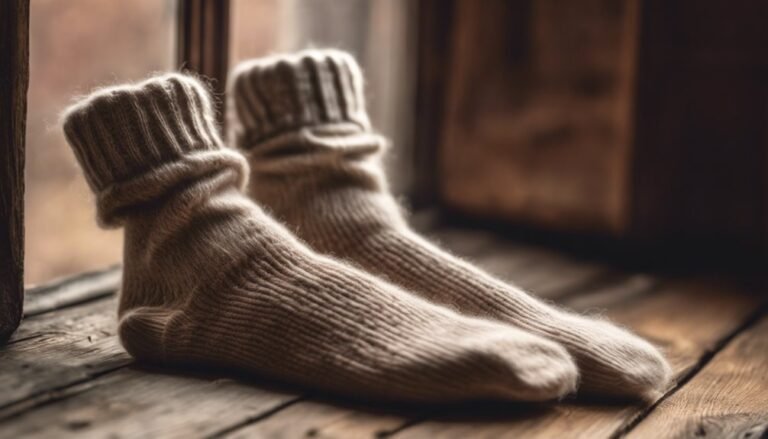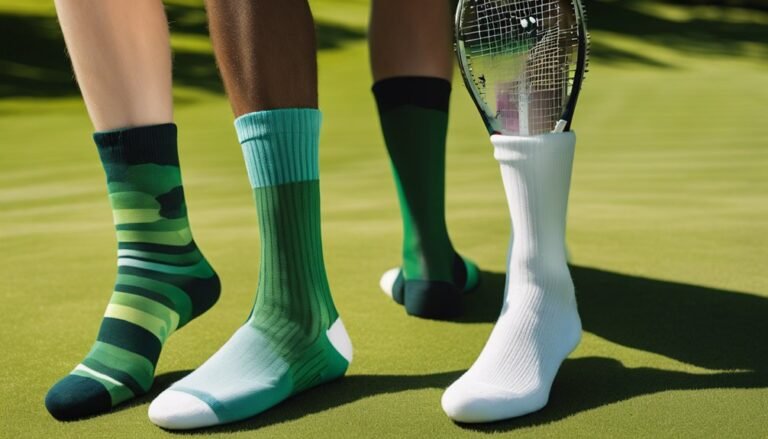Football Socks vs. Rugby Socks: Which Lasts Longer?
When comparing football socks to rugby socks, you'll find that football socks typically last longer. This longevity is due to their materials, like synthetic fibers that enhance durability, and design elements focused on moisture control. Rugby socks, however, face harsher conditions and as a result experience quicker wear and tear. The choice of padding and moisture management also plays a role in their performance. For a deeper understanding of these factors, you'll discover more insights ahead.
Understanding the Materials Used in Football and Rugby Socks

When it comes to performance on the field, the materials used in football and rugby socks play an essential role in comfort and functionality. You'll find a variety of sock materials, each designed to meet specific needs. For instance, synthetic fibers like polyester and nylon offer superior fabric durability, ensuring that your socks withstand the rigors of intense play. Merino wool, known for its moisture-wicking properties, provides comfort but may not match synthetic materials regarding longevity. Additionally, some socks incorporate spandex for enhanced elasticity, contributing to a secure fit. Understanding these distinctions helps you choose the right sock for your sport, balancing comfort, durability, and performance. Ultimately, the right sock materials can enhance your experience on the field.
Design Features: How They Impact Durability
While the choice of material is essential, the design features of football and rugby socks also greatly impact their durability. For instance, sock padding is imperative; it provides additional protection against wear while enhancing comfort. In football, padding is often strategically placed to absorb impact, which can help the socks last longer. Conversely, rugby socks may focus more on flexibility and compression, potentially sacrificing some durability for enhanced fit. Additionally, moisture control features can play an important role. Socks designed with moisture-wicking properties reduce sweat buildup, minimizing the risk of deterioration from dampness. Ultimately, the design choices made regarding padding and moisture management can greatly affect how long your socks will endure the rigors of the game.
Performance Under Pressure: Testing Longevity
Although both football and rugby socks are designed for high-performance sports, their longevity under pressure can vary considerably due to the demands of each game. In pressure testing, rugby socks often face harsher conditions, including intense tackles and prolonged scrums, which can lead to faster wear and tear. Football socks, while also subjected to rigorous movement, typically endure less direct contact, allowing for a more extended lifespan. A longevity comparison reveals that rugby socks may need replacement more frequently, especially if you're a regular player. The material and design differences play a significant role in these outcomes, impacting overall performance. Ultimately, understanding these factors can help you choose the right sock for your sport and playing style.
Care and Maintenance Tips for Extended Sock Life

Understanding the longevity of your socks is just the beginning; proper care and maintenance can greatly extend their life. For sock washing, always follow the manufacturer's instructions, opting for cold water to preserve elasticity and color. Avoid bleach, as it weakens fibers over time. When it comes to drying techniques, skip the dryer if possible. Instead, air dry your socks flat or hang them to prevent shrinkage and damage. If you must use a dryer, choose a low heat setting. Regularly inspect your socks for wear and tear, addressing small issues before they escalate. By adopting these practices, you'll keep your socks performing well, allowing you to enjoy their comfort and support longer.
Player Preferences: Insights From the Field
When it comes to sock selection, players often have strong preferences influenced by their sport's demands and personal comfort. Football players typically prioritize moisture-wicking materials and compression features, valuing how these aspects can enhance performance. In contrast, rugby players often seek thicker, cushioned socks for added protection during intense physical contact. Player feedback consistently highlights sock comfort as a critical factor; discomfort can lead to distractions on the field. Curiously, many athletes report that the right sock can boost their confidence, contributing to overall gameplay. Ultimately, the choice between football and rugby socks often comes down to individual needs and expectations, shaped by the specific challenges encountered in each sport.
Frequently Asked Questions
What Brands Are Known for Durable Football and Rugby Socks?
When it comes to durability, you might find brands like Nike and Under Armour stand tall. Their sock materials often outperform others, making brand comparisons essential for those seeking long-lasting performance on the field.
Are There Specific Socks for Different Weather Conditions?
Yes, there're specific socks designed for varying weather conditions. Look for options with weather adaptability and moisture control features to guarantee comfort and performance, keeping your feet dry and regulated in diverse climates.
Can I Use Football Socks for Rugby and Vice Versa?
When choosing socks, think of them as armor for your feet. While football socks and rugby socks share similarities, their sport-specific designs and sock material comparisons can impact performance, so it's best to choose wisely.
How Do Sock Sizes Affect Longevity and Fit?
Sock sizes greatly affect fit and longevity. Using a proper size chart guarantees ideal comfort and prevents material strain, which can lead to faster wear. Sock material also plays an essential role in durability and performance.
Do Professional Players Endorse Specific Sock Brands for Durability?
You'd think professional players would just wear any old socks, but they often endorse specific brands. These endorsements are influenced by advanced sock technology, highlighting durability and performance that can't be ignored in competitive sports.







